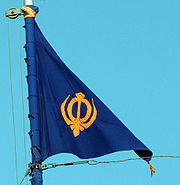
Nishan Sahib
Encyclopedia


Sikh
A Sikh is a follower of Sikhism. It primarily originated in the 15th century in the Punjab region of South Asia. The term "Sikh" has its origin in Sanskrit term शिष्य , meaning "disciple, student" or शिक्ष , meaning "instruction"...
holy triangular flag made of cotton or silk cloth, with a tassel at its end. The word, Nishan means symbol, and the flag is hoisted on a tall flagpole, outside most Gurudwaras. The flagpole itself covered with fabric, ends with a two-edged dagger (khanda
Khanda (sword)
The blade is usually broad and quite heavy and broadens from the hilt to the tip. The blade transforms into tip rather abruptly. The hilt has a small metal spike coming out in the opposite direction typical of the khanda...
) on top. The emblem on the flag is known as Khanda, which depicts a double-edged sword called a khanda
Khanda (sword)
The blade is usually broad and quite heavy and broadens from the hilt to the tip. The blade transforms into tip rather abruptly. The hilt has a small metal spike coming out in the opposite direction typical of the khanda...
(☬) in the centre, a chakkar
Chakram
The chakram , sometimes called a war quoit, is a throwing weapon from India. Its shape is of a flat metal hoop with a sharp outer edge from in diameter...
which is circular, and flanked by two single-edged swords, or kirpan
Kirpan
The kirpan is a ceremonial sword or dagger carried by orthodox Sikhs. It is a religious commandment given by Guru Gobind Singh at the Baisakhi Amrit Sanchar in CE 1699, all baptised Sikhs must wear a kirpan at all times....
s.
Traditional symbol of the Khalsa Panth, the Nishan Sahib can be seen from far away, signifying the presence of Khalsa in the neighbourhood. It is taken down every Baisakhi, and replaced with a fresh flag, and the flagpole refurbished.
History
The background colour of the Nishan Sahib during the early phase of Sikh history was redRed
Red is any of a number of similar colors evoked by light consisting predominantly of the longest wavelengths of light discernible by the human eye, in the wavelength range of roughly 630–740 nm. Longer wavelengths than this are called infrared , and cannot be seen by the naked eye...
. Its colour underwent a change, from white to saffron
Saffron (color)
Saffron is a color that is a tone of golden yellow resembling the color of the tip of the saffron crocus thread, from which the spice saffron is derived.The first recorded use of saffron as a color name in English was in 1200...
, in the hands of Guru Hargobind and it was hoisted for the first time at Akal Takhat Sahib
Akal Takht
The Akal Takht of the Timeless One or Seat of God. It is one of the five seats of temporal authority of the Sikhs equivalent to any parliament of world sovereign country. Akal means The Timeless One - another term for God. Takht means 'seat' or 'throne' in Persian...
in the year 1609 CE. However, it is steel blue
Steel blue
Steel blue is a shade of blue that resembles blue steel, i.e., steel which has been subjected to bluing in order to protect it from rust. It is one of the less vibrant shades of blue; usually identified as somewhat bluish-grey....
in colour at Gurudwaras managed by Nihang
Nihang
Nihang is an armed Sikh order. Early Sikh military history is dominated by the Akali Nihang military order, particularly for many famous military victories won while often heavily outnumbered. The Akali Nihang have historically been held in great affection and respect by Sikhs due the pivotal role...
s.
Overview


Gurdwara
A Gurdwara , meaning the Gateway to the Guru, is the place of worship for Sikhs, the followers of Sikhism. A Gurdwara can be identified from a distance by tall flagpoles bearing the Nishan Sahib ....
and is supported by a pole of timber or metal.
The Khanda, a Sikh symbol, is rendered in blue
Blue
Blue is a colour, the perception of which is evoked by light having a spectrum dominated by energy with a wavelength of roughly 440–490 nm. It is considered one of the additive primary colours. On the HSV Colour Wheel, the complement of blue is yellow; that is, a colour corresponding to an equal...
on the saffron background. The khanda is placed high up on a flagpole as a sign for all Sikhs and indeed any other people that they can come and pray in this building. Great respect is shown to this flag which is shown by its washing using milk and water every year in April at the festival of Vaisakhi
Vaisakhi
Vaisakhi is an ancient harvest festival celebrated across North Indian states, especially Punjab by all Punjabis regardless of religion. In Sikhism the Khalsa was founded on same day as the Vaisakhi festival, so Sikhs celebrate twice as much....
. The Nishan Sahib is changed once the saffron color has faded.
Like a Flag of any institution, this Flag symbolizes the presence of the Khalsa
Khalsa
+YouWebImagesVideosMapsNewsMailMoreTranslateFrom: ArabicTo: EnglishEnglishHindiEnglishAllow phonetic typingHindiEnglishArabicAssumptionGoogle Translate for Business:Translator ToolkitWebsite TranslatorGlobal Market Finder...
and hence is hoisted at every Gurdwara premises. Therefore, anybody in need of help. However, with the Khalsa
Khalsa
+YouWebImagesVideosMapsNewsMailMoreTranslateFrom: ArabicTo: EnglishEnglishHindiEnglishAllow phonetic typingHindiEnglishArabicAssumptionGoogle Translate for Business:Translator ToolkitWebsite TranslatorGlobal Market Finder...
now being non-functional, the Gurdwaras serve the purpose of congregational meeting, Langar
Langar
Langar is the term used in the Sikh religion or in Punjab in general for common kitchen/canteen where food is served in a Gurdwara to all the visitors for free. At the langar, only vegetarian food is served, to ensure that all people, regardless of their dietary restrictions, can eat as equals...
and lodging.

